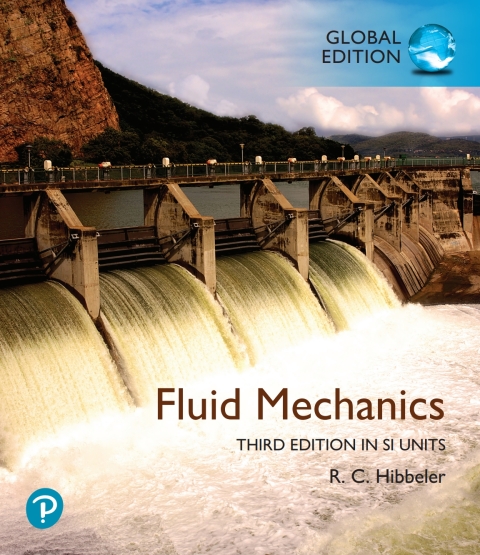Description
Efnisyfirlit
- Half Title
- Title Page
- Copyright Page
- To the Student
- Preface
- Your work…
- With the Power of Mastering Engineering for Fluid Mechanics
- Credits
- Contents
- Chapter 1. Fundamental Concepts
- Chapter Objectives
- 1.1 Introduction
- 1.2 Characteristics of Matter
- 1.3 Systems of Units
- 1.4 Calculations
- 1.5 Problem Solving
- 1.6 Some Basic Fluid Properties
- 1.7 Viscosity
- 1.8 Viscosity Measurement
- 1.9 Vapor Pressure
- 1.10 Surface Tension and Capillarity
- References
- Problems
- Conceptual Problems
- Chapter Review
- Chapter 2. Fluid Statics
- Chapter Objectives
- 2.1 Pressure
- 2.2 Absolute and Gage Pressure
- 2.3 Static Pressure Variation
- 2.4 Pressure Variation for Incompressible Fluids
- 2.5 Pressure Variation for Compressible Fluids
- 2.6 Measurement of Static Pressure
- 2.7 Hydrostatic Force on a Plane Surface—Formula Method
- 2.8 Hydrostatic Force on a Plane Surface—Geometrical Method
- 2.9 Hydrostatic Force on a Plane Surface—Integration Method
- 2.10 Hydrostatic Force on an Inclined Planeor Curved Surface
- 2.11 Buoyancy
- 2.12 Stability
- 2.13 Constant Translational Acceleration of a Liquid
- 2.14 Steady Rotation of a Liquid
- References
- Fundamental Problems
- Problems
- Conceptual Problems
- Chapter Review
- Chapter 3. Kinematics of Fluid Motion
- Chapter Objectives
- 3.1 Graphical Descriptions of Fluid Flow
- 3.2 Velocity
- 3.3 Fluid Acceleration
- 3.4 Streamline Coordinates
- References
- Fundamental Problems
- Problems
- Chapter Review
- Chapter 4. Flow and the Conservation of Mass
- Chapter Objectives
- 4.1 Volumetric Flow, Mass Flow, and Average Velocity
- 4.2 Flow Classification
- 4.3 Finite Control Volumes
- 4.4 The Reynolds Transport Theorem
- 4.5 Conservation of Mass
- References
- Fundamental Problems
- Problems
- Conceptual Problems
- Chapter Review
- Chapter 5. Work and Energy
- Chapter Objectives
- 5.1 Euler’s Equations of Motion
- 5.2 The Bernoulli Equation
- 5.3 Applications of the Bernoulli Equation
- 5.4 Energy and Hydraulic Grade Lines
- 5.5 The Energy Equation
- References
- Fundamental Problems
- Problems
- Chapter Review
- Chapter 6. Fluid Momentum
- Chapter Objectives
- 6.1 The Linear Momentum Equation
- 6.2 Applications to Bodies at Rest
- 6.3 Applications to Bodies Having Constant Velocity
- 6.4 The Angular Momentum Equation
- 6.5 Propellers and Wind Turbines
- 6.6 Applications for Control Volumes Having Accelerated Motion
- 6.7 Turbojets and Turbofans
- 6.8 Rockets
- References
- Fundamental Problems
- Problems
- Conceptual Problems
- Chapter Review
- Chapter 7. Differential Fluid Flow
- Chapter Objectives
- 7.1 Differential Analysis
- 7.2 Kinematics of Differential Fluid Elements
- 7.3 Circulation and Vorticity
- 7.4 Conservation of Mass
- 7.5 Equations of Motion for a Fluid Particle
- 7.6 The Euler and Bernoulli Equations
- 7.7 Potential Flow Hydrodynamics
- 7.8 The Stream Function
- 7.9 The Potential Function
- 7.10 Basic Two-Dimensional Flows
- 7.11 Superposition of Flows
- 7.12 The Navier–Stokes Equations
- 7.13 Computational Fluid Dynamics
- References
- Problems
- Chapter Review
- Chapter 8. Dimensional Analysis and Similitude
- Chapter Objectives
- 8.1 Dimensional Analysis
- 8.2 Important Dimensionless Numbers
- 8.3 The Buckingham Pi Theorem
- 8.4 Some General Considerations Related to Dimensional Analysis
- 8.5 Similitude
- References
- Problems
- Chapter Review
- Chapter 9. Viscous Flow within Enclosed Conduits
- Chapter Objectives
- 9.1 Steady Laminar Flow between Parallel Plates
- 9.2 Navier–Stokes Solution for Steady Laminar Flow between Parallel Plates
- 9.3 Steady Laminar Flow within a Pipe
- 9.4 Navier–Stokes Solution for Steady Laminar Flow within a Pipe
- 9.5 The Reynolds Number
- 9.6 Fully Developed Flow from an Entrance
- 9.7 Laminar and Turbulent Shear Stress within a Pipe
- 9.8 Steady Turbulent Flow within a Pipe
- References
- Problems
- Chapter Review
- Chapter 10. Analysis and Design for Pipe Flow
- Chapter Objectives
- 10.1 Resistance to Flow in Pipes
- 10.2 Losses Occurring from Pipe Fittings and Transitions
- 10.3 Single-Pipeline Flow
- 10.4 Pipe Systems
- 10.5 Flow Measurement
- References
- Fundamental Problems
- Problems
- Chapter Review
- Chapter 11. Viscous Flow over External Surfaces
- Chapter Objectives
- 11.1 The Concept of the Boundary Layer
- 11.2 Laminar Boundary Layers
- 11.3 The Momentum Integral Equation
- 11.4 Turbulent Boundary Layers
- 11.5 Laminar and Turbulent Boundary Layers
- 11.6 Drag and Lift
- 11.7 Pressure Gradient Effects
- 11.8 The Drag Coefficient
- 11.9 Drag Coefficients for Bodies Having Various Shapes
- 11.10 Methods for Reducing Drag
- 11.11 Lift and Drag on an Airfoil
- References
- Problems
- Conceptual Problems
- Chapter Review
- Chapter 12. Open-Channel Flow
- Chapter Objectives
- 12.1 Types of Flow in Open Channels
- 12.2 Open-Channel Flow Classifications
- 12.3 Specific Energy
- 12.4 Open-Channel Flow over a Rise or Bump
- 12.5 Open-Channel Flow under a Sluice Gate
- 12.6 Steady Uniform Channel Flow
- 12.7 Gradually Varied Flow
- 12.8 The Hydraulic Jump
- 12.9 Weirs
- References
- Problems
- Chapter Review
- Chapter 13. Compressible Flow
- Chapter Objectives
- 13.1 Thermodynamic Concepts
- 13.2 Wave Propagation through a Compressible Fluid
- 13.3 Types of Compressible Flow
- 13.4 Stagnation Properties
- 13.5 Isentropic Flow through a Variable Area
- 13.6 Isentropic Flow through Converging and Diverging Nozzles
- 13.7 The Effect of Friction on Compressible Flow
- 13.8 The Effect of Heat Transfer on Compressible Flow
- 13.9 Normal Shock Waves
- 13.10 Shock Waves in Nozzles
- 13.11 Oblique Shock Waves
- 13.12 Compression and Expansion Waves
- 13.13 Compressible Flow Measurement
- References
- Problems
- Chapter Review
- Chater 14. Turbomachines
- Chapter Objectives
- 14.1 Types of Turbomachines
- 14.2 Axial-Flow Pumps
- 14.3 Radial-Flow Pumps
- 14.4 Ideal Performance for Pumps
- 14.5 Turbines
- 14.6 Pump Performance
- 14.7 Cavitation and the Net Positive Suction Head
- 14.8 Pump Selection Related to the Flow System
- 14.9 Turbomachine Similitude
- References
- Problems
- Chapter Review
- Appendices
- Appendix A. Physical Properties of Fluids
- Appendix B. Compressible Properties of a Gas (k = 1.4)
- Fundamental Problem Solutions
- Answers to Selected Problems
- Index
- A
- B
- C
- D
- E
- F
- G
- H
- I
- K
- L
- M
- N
- O
- P
- Q
- R
- S
- T
- U
- V
- W
- Z
- Fundamental Equations of Fluid Mechanics
- SI Prefixes and Conversion Factors
- Geometric Properties of a Planar Area
- Surface Roughness for New Pipe







Reviews
There are no reviews yet.